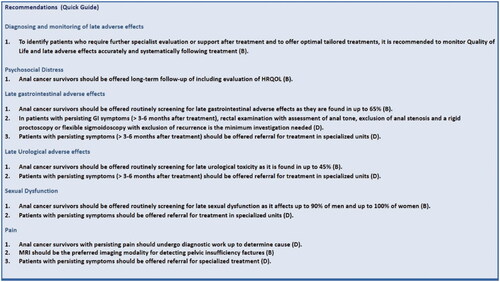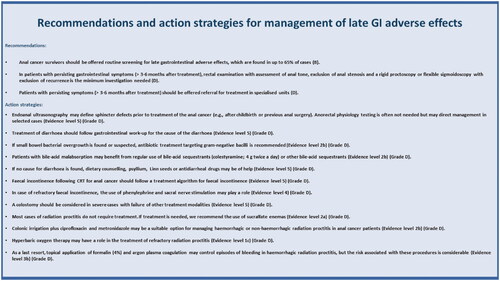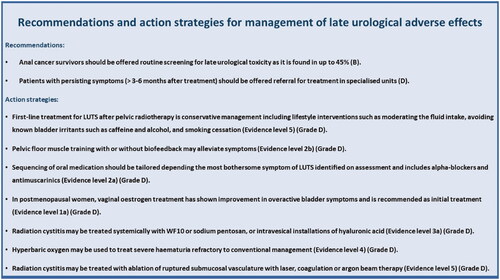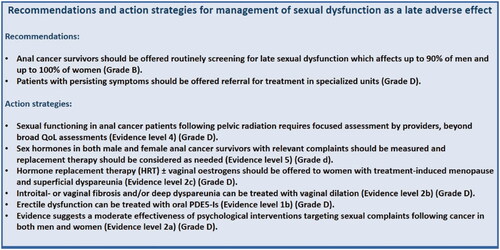Figures & data
Figure 1. Guideline recommendations based upon direct research evidence. Recommendations marked A are the strongest, whereas recommendations marked D are the weakest according to the “Oxford Centre for Evidence-Based Medicine Levels of Evidence and Grades of Recommendations”.

Figure 2. Recommendations and action strategies for management of psychosocial distress. The recommendations are based upon direct research evidence whereas action strategies are based on relevant literature concerning pelvic radiation disease in general. Recommendations marked A are the strongest, whereas recommendations marked D are the weakest according to the “Oxford Centre for Evidence-Based Medicine Levels of Evidence and Grades of Recommendations”. As action strategies are not based direct research evidence these are all marked D, however the quality of the associated literature is listed with evidence level.

Figure 3. Recommendations and action strategies for management of late GI adverse effects. The recommendations are based upon direct research evidence whereas action strategies are based on relevant literature concerning pelvic radiation disease in general. Recommendations marked A are the strongest, whereas recommendations marked D are the weakest according to the “Oxford Centre for Evidence-Based Medicine Levels of Evidence and Grades of Recommendations”. As action strategies are not based direct research evidence these are all marked D, however the quality of the associated literature is listed with evidence level.

Figure 4. Recommendations and action strategies for management of late urological adverse effects. The recommendations are based upon direct research evidence whereas action strategies are based on relevant literature concerning pelvic radiation disease in general. Recommendations marked A are the strongest, whereas recommendations marked D are the weakest according to the “Oxford Centre for Evidence-Based Medicine Levels of Evidence and Grades of Recommendations”. As action strategies are not based direct research evidence these are all marked D, however the quality of the associated literature is listed with evidence level.

Figure 5. Recommendations and action strategies for management of sexual dysfunction. The recommendations are based upon direct research evidence whereas action strategies are based on relevant literature concerning pelvic radiation disease in general. Recommendations marked A are the strongest, whereas recommendations marked D are the weakest according to the “Oxford Centre for Evidence-Based Medicine Levels of Evidence and Grades of Recommendations”. As action strategies are not based direct research evidence these are all marked D, however the quality of the associated literature is listed with evidence level.

Figure 6. Recommendations and action strategies for management of pain. The recommendations are based upon direct research evidence whereas action strategies are based on relevant literature concerning pelvic radiation disease in general. Recommendations marked A are the strongest, whereas recommendations marked D are the weakest according to the “Oxford Centre for Evidence-Based Medicine Levels of Evidence and Grades of Recommendations”. As action strategies are not based direct research evidence these are all marked D, however the quality of the associated literature is listed with evidence level.

Figure 7. Recommendations and action strategies for management of radiation dermatitis. The recommendations are based upon direct research evidence whereas action strategies are based on relevant literature concerning pelvic radiation disease in general. Recommendations marked A are the strongest, whereas recommendations marked D are the weakest according to the “Oxford Centre for Evidence-Based Medicine Levels of Evidence and Grades of Recommendations”. As action strategies are not based direct research evidence these are all marked D, however the quality of the associated literature is listed with evidence level.

